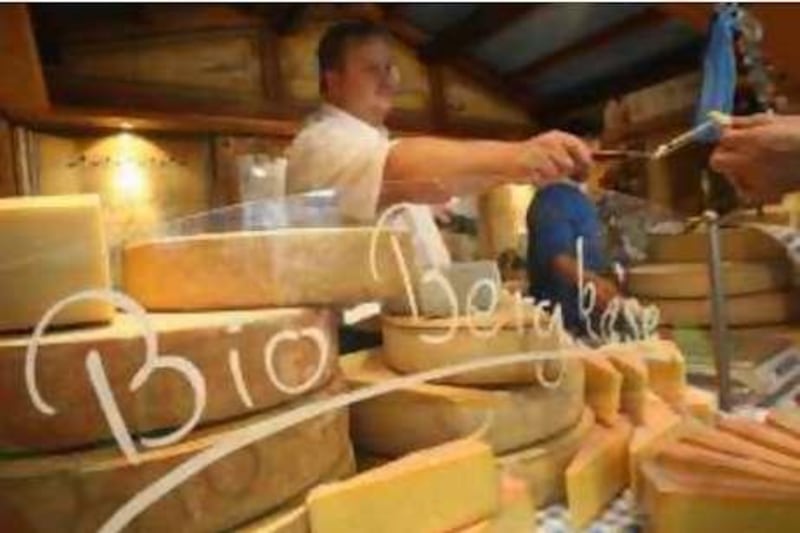The new year is often the time of stern pledges of dietary asceticism, but let's face it; most of us will have fallen off the wagon before the end of New Year's Eve. Instead, why not pledge to make 2009 a year of culinary exploration. Each month offers a new destination and a new chance to expand our horizons. Today we take a look at some of the top food events in the foodie calendar.
It is perhaps not such lighthearted fun as a festival devoted to cheese or chocolate, but for those who are curious Berlin's International Green Week gives a fascinating insight into the current state of play in green agriculture and food production. With companies flying in from all over the world to show off their latest products and innovations - all of which are related to food this year - it's a great place to learn about anything from organic tea production to fair-trade kumquats.
A meeting of the world's top culinary minds, Milan's Identita Golose festival-cum-congress is probably the best place in the world to find out what restaurants worldwide will be cooking up over the next few years. This year's programme of seminars and demonstrations will feature such culinary heavyweights as the molecular gastronome Ferran Adrià of Catalonia's El Bulli and the rising star René Redzepi of Copenhagen's Noma, and is bound to be packed with foodies, restaurateurs and journalists trying to stay one step ahead of the game. The festival also works with top local restaurants to showcase the best of Milan's traditional regional cooking, a wonderfully rich, surprisingly un-Mediterranean cuisine thatis not easily sampled outside Italy.
It's hardly surprising to learn that the Swiss eat more chocolate than anyone else in the world (12.3 kilos per head annually, to be precise). Well they would. Their chocolate is just so much better. One of the best places to taste it is the Eurochocolate festival, taking place in March in the almost eerily pretty lakeside town of Lugano. Along with infinite opportunities to buy some of the best chocolate available, the festival also includes chocolate-making workshops, educational sessions and even chocolate sculpture.
It's not exactly haute cuisine, but this festival, taking place every Easter Monday in France's Tarn Valley, is still one of the most endearingly silly the world has to offer. For the past 34 years, the villagers have clubbed together to make a vast 12,000 egg omelette, using a 3.4-metre-wide pan and a modest 25 litres of oil. Portions of the omelette are handed out free to anyone watching.
Celebrating Midsummer's Day in the middle of winter may seem odd, but Brazil's St John's Day is a classic example of how European customs can be turned upside down south of the equator and still lose nothing for it. This originally Portuguese festival is celebrated at the beginning of Brazil's winter, an excellent time for an open air festival as the air is mercifully cooler. Celebrated by jumping over bonfires and other public pyrotechnic displays, the day is also an opportunity for a major feast both at home and in restaurants. Dishes made with corn are invariably a feature of any St John's Day menu, but Brazilian classics such as feijoada (black bean and stew with toasted cassava), coconut pudding and massive barbecues of just about any part of a cow are also hugely popular. Once you're sufficiently stuffed, you can waddle out into the street and dance it all off.
Chicago may host America's best-known food festival (Taste of Chicago), but Bite of Seattle is the country's rising star. All those IT millions have pumped enough cash into the north-western city's restaurant sector to make it a great place for fine dining, while the city's Pike Place Market is one of the US's most attractive places to buy top quality produce (especially seafood). And don't forget coffee. Seattle's caffeine boom of the 1990s may have launched a million insipid franchise branches upon the world, but the original bars that inspired the likes of Starbucks are miles ahead in quality and atmosphere. Bite of Seattle brings all these attractions together under one manageable roof. Over 50 restaurants participate in the festival, serving affordable tasting portions of their best dishes, giving you an excellent introduction into exactly what the city offers.
It's funny to think that snobbish Anglophones used to consider garlic eating as a mark of the Mediterranean nations' lack of good manners. Nowadays, the bulb is relished pretty much everywhere in the English-speaking world, most notably at this California festival. Now attracting more than 100,000 visitors annually, the event includes a gourmet alley of garlic treats, a recipe contest and cook-off - and even a Miss Gilroy Garlic beauty contest. For sufferers from halitosis, it has the added advantage of being one public event where no one is likely to give you a hard time.
The Ludlow Food Festival isn't Britain's largest foodie event, just its best. Despite its size, this small English town has become the country's main gastro magnet in recent years, achieving fame for its numerous Michelin-starred restaurants (many of which have, alas, since relocated to London) and its fine farmers' markets. It shows its best side during its annual festival, when small-scale farmers and producers from across the region converge to promote their often excellent traditional wares. Beyond stuffing yourself, seeing this winsomely picturesque town in late summer sunshine is also a good reason to visit.
Any time of the year is a good one to try China's huge range of excellent food, but the mid-autumn or moon cake festival makes for a particularly good time to schedule a visit. The festival commemorates the date when the goddess Chang'e was banished to the moon (along with her rabbit), a mythical event that has long proved a popular subject for Chinese poetry, and takes place on the 15th day of the eighth month in the Chinese calendar (Oct 3 this year). Never ones to miss the opportunity to indulge in a good feast, the Chinese celebrate with a blowout, scoffing moon cakes: dense, rich pastries made with lotus seed and red bean paste. The festival takes place all over China, but Hong Kong's version stands out, as its citizens come out at dusk to fill parks and gardens with coloured lanterns, and even lay on a 67-metre-long "fire dragon" to parade through the night-time streets.
The Balinese traditionally believe that the spirits of the ancestors return to their living families' homes every 210 days. Celebrating this happy return with the festival of Galungan (which also takes place in March this year), people make sure that their spirit kinsfolk feel as welcome as possible by preparing them a delicious meal. The meal usually includes freshly slaughtered meat, pounded and formed into spiced satay skewers, and many vegetable dishes. Altogether, it often takes over a day to prepare. In an extra bid to welcome the spirits back, householders hang woven bamboo poles called "penjor" outside their front gates, often covered with sweets, fruit and cakes. Given Bali's popularity with tourists, Galungan feasts showcasing the best of local cooking are also widely available in restaurants catering to visitors, making it by far the best time to experience the variety of local cuisine.
Not a month later comes another festival commemorating departed loved ones - one even more fixated with food. Much like the Balinese, the Mexicans have developed the perversely charming custom of cooking dead relatives their favourite meal. Each November, families return to the graves of loved ones to eat a celebratory feast, typically of special-occasion dishes such as mole poblano (turkey in chocolate spice sauce). With the streets festooned with macabre banners of skeletons, the Day of the Dead is an ideal time to learn how much better Mexican food is than flabby Tex-Mex tacos and gloopy chilli. What might be a rather gloomy event in other countries is full of carnival-like fun and excitement, with restaurants packed out with families enjoying vast meals and the streets busy throughout the night. If you're in Mexico for the festival, don't forget to pick up multicoloured sugar skulls to take home - while adults find them a little grisly, kids love them.
One of the world's most expensive foods, white truffles can sell for a staggering 400 euros (Dh 2,000) a kilo. But while they are an increasingly familiar (if sparingly employed) feature of haute cuisine, truffles lose much of their flavour if they are left unused for long after being unearthed. If you want to enjoy the rare pleasure of tasting rich, intensely perfumed truffles just after they've been gathered, head to a truffle producing centre such as San Miniato in Tuscany. This ancient cathedral city, the focal point for Italy's crop, hosts a truffle festival each October, where stalls and a host of local restaurants club together to serve up truffle delicacies. While prices are not low, the pleasure of eating specialities such as buttered tagliatelle, served with slivers of truffle fresh from the ground, will make your visit here a joy.





